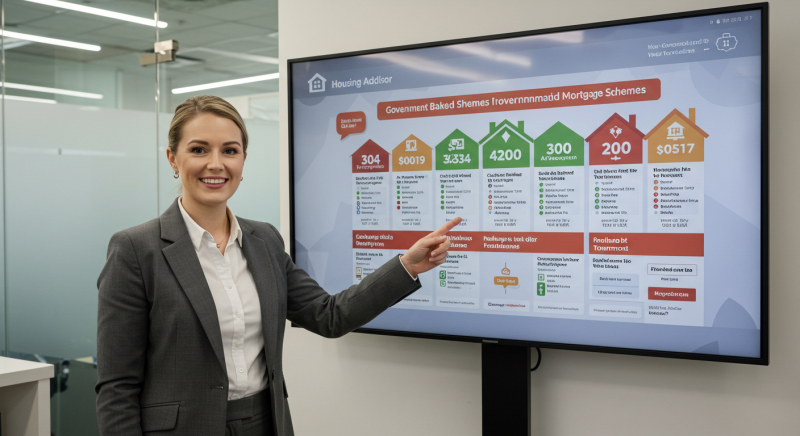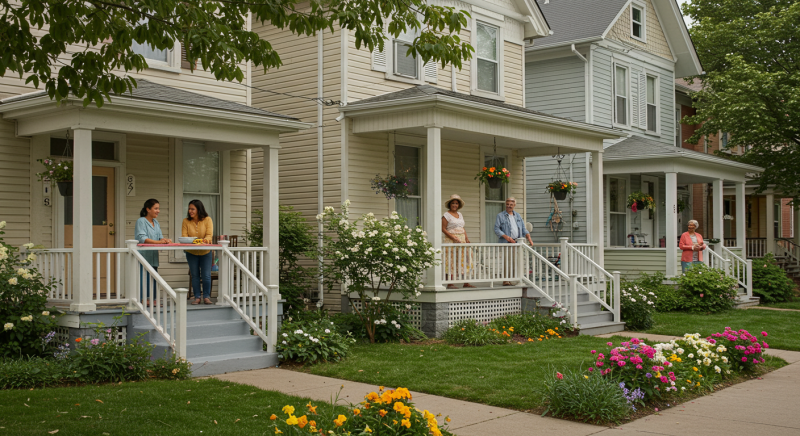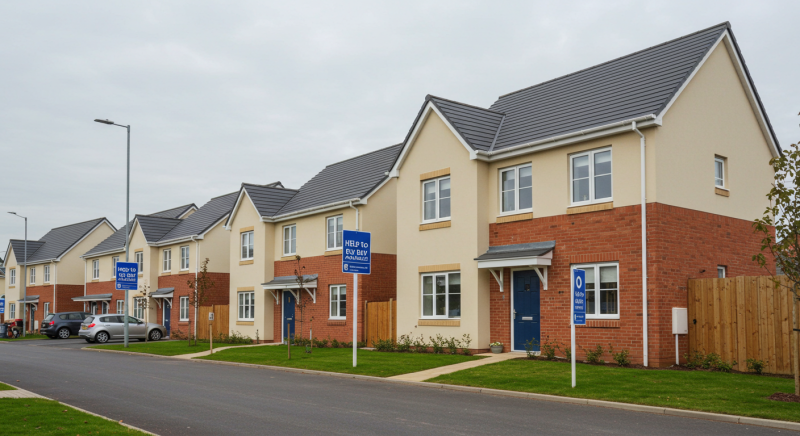Understanding Government-Backed Mortgage Schemes That Transform Home Ownership Dreams
The journey to homeownership in the UK can feel overwhelming, especially with today’s challenging property market. For countless families and individuals, government-backed mortgage schemes have become the crucial lifeline that bridges the gap between aspiration and achievement. These government-backed mortgage schemes provide vital support that makes the seemingly impossible dream of owning a home a tangible reality for thousands across the nation.
Key Takeaways:
- Government-backed mortgage schemes are specifically designed to help various groups overcome barriers to homeownership
- Several active schemes exist including Help to Buy, Shared Ownership, Mortgage Guarantee, and First Homes
- Each government-backed mortgage scheme targets different challenges in the housing market
- Eligibility requirements vary between government-backed mortgage schemes, requiring careful research
- Most government-backed mortgage schemes require working with approved lenders or housing associations
- Recent changes to government-backed mortgage schemes have expanded accessibility for more potential homebuyers
When the door to homeownership seems firmly closed, government-backed mortgage schemes can provide the key that unlocks possibilities. For many people, particularly first-time buyers, these initiatives represent not just financial assistance but the emotional fulfillment of establishing roots, building equity, and achieving life milestones that might otherwise remain frustratingly out of reach.

The Current Landscape of Government-Backed Mortgage Schemes
The UK housing market continues to present significant challenges for potential homebuyers. According to recent data from HM Land Registry, average house prices have consistently outpaced wage growth over the past decade. This disparity has created a situation where government-backed mortgage schemes have become increasingly essential tools for facilitating homeownership.
Government-backed mortgage schemes function through various mechanisms, but they all share the common purpose of reducing barriers to entry into the property market. Whether by decreasing deposit requirements, sharing ownership costs, or providing guarantees to lenders, these schemes create pathways where traditional mortgage options fall short.
Major Government-Backed Mortgage Schemes in the UK
Help to Buy Equity Loan
The Help to Buy Equity Loan scheme represents one of the most significant government-backed mortgage schemes introduced in recent years. While the original nationwide scheme closed to new applications in October 2022, regional variations continue in some areas, and its impact on the market remains substantial.
Under this government-backed mortgage scheme, first-time buyers could receive an equity loan for up to 20% of a newly built home’s purchase price (40% in London). This allowed purchasers to secure a property with just a 5% deposit, with the government loan remaining interest-free for the first five years.
Research from the Ministry of Housing, Communities & Local Government found that over 335,000 properties were purchased using the Help to Buy Equity Loan scheme since its inception, demonstrating the significant reach of this government-backed mortgage scheme.
Shared Ownership
Shared Ownership stands as another cornerstone among government-backed mortgage schemes. This approach allows buyers to purchase a share of a property (between 10% and 75%) while paying rent on the remaining portion, typically owned by a housing association.
What makes this government-backed mortgage scheme particularly valuable is its “staircasing” feature, which enables homeowners to gradually increase their ownership share over time. Data from the National Housing Federation indicates that approximately 200,000 UK households currently live in shared ownership homes, highlighting the scheme’s importance in the mortgage landscape.
The deposit requirements for Shared Ownership are calculated based on the share being purchased rather than the total property value, making this government-backed mortgage scheme accessible to those with limited savings. For example, a 5% deposit on a 25% share of a £300,000 property would be just £3,750, compared to £15,000 for a conventional purchase.
Mortgage Guarantee Scheme
Introduced during the economic uncertainty following the COVID-19 pandemic, the Mortgage Guarantee Scheme represents a more recent addition to government-backed mortgage schemes. This initiative provides lenders with the confidence to offer high loan-to-value mortgages by guaranteeing a portion of the loan against default.
This government-backed mortgage scheme enables qualified buyers to secure mortgages with just a 5% deposit on properties valued up to £600,000. According to HM Treasury data, over 24,000 households successfully used the scheme in its first year of operation, demonstrating its effectiveness as a government-backed mortgage scheme for those struggling with large deposit requirements.
First Homes Scheme
The First Homes scheme, launched in 2021, represents one of the newer government-backed mortgage schemes available. This initiative offers newly built homes at a discount of at least 30% compared to market value for first-time buyers who meet local connection and income criteria.
This government-backed mortgage scheme ensures the discount is passed on to future buyers when the property is sold, creating permanently affordable housing. The maximum property value after discount is £250,000 across most of England and £420,000 in London, making this government-backed mortgage scheme particularly valuable in high-cost areas.
Navigating Eligibility for Government-Backed Mortgage Schemes
Understanding eligibility criteria is crucial when exploring government-backed mortgage schemes. While requirements vary between programs, common factors include:
For most government-backed mortgage schemes, first-time buyer status is often but not always required. Income thresholds also apply, with many government-backed mortgage schemes targeted at households earning under £80,000 (£90,000 in London). Property price caps ensure that these government-backed mortgage schemes focus on entry and mid-level market segments rather than luxury properties.
Research published in the International Journal of Housing Policy indicates that successful applicants for government-backed mortgage schemes typically spend 3-6 months preparing their finances before application. This preparation includes improving credit scores, stabilizing employment history, and accumulating sufficient savings for associated costs beyond the deposit.

How to Apply for Government-Backed Mortgage Schemes
The application process for government-backed mortgage schemes typically involves several key stages. Initially, prospective homebuyers should research available schemes through official government websites like Help to Buy (https://www.helptobuy.gov.uk/) and the Shared Ownership portal (https://www.sharedownership.co.uk/).
After identifying suitable government-backed mortgage schemes, applicants need to verify their eligibility through official assessment processes. For most government-backed mortgage schemes, working with approved lenders or housing associations is essential, as standard mortgage providers may not participate in all programs.
Financial preparation represents a critical aspect of accessing government-backed mortgage schemes. Beyond the deposit requirements, applicants should account for solicitor fees, survey costs, and potential stamp duty obligations. Government-backed mortgage schemes reduce but don’t eliminate these associated expenses.
Recent Developments in Government-Backed Mortgage Schemes
The landscape of government-backed mortgage schemes continues to evolve in response to market conditions and policy priorities. Recent modifications to several government-backed mortgage schemes have expanded accessibility while addressing concerns about property supply and affordability.
In particular, adjustments to the Shared Ownership scheme have reduced the minimum initial share from 25% to 10%, making this government-backed mortgage scheme accessible to a broader range of potential buyers. Similarly, changes to the First Homes scheme have strengthened local connection requirements, ensuring these government-backed mortgage schemes benefit community members facing housing challenges.
Analysis from the UK Housing Review 2023 suggests that government-backed mortgage schemes will continue to play an increasingly important role in housing policy, with projections indicating that up to 40% of first-time buyers may utilize some form of government-backed mortgage scheme by 2026.
Maximizing Benefits from Government-Backed Mortgage Schemes
To derive maximum advantage from government-backed mortgage schemes, prospective homebuyers should adopt strategic approaches. Understanding the long-term implications of each government-backed mortgage scheme remains essential, particularly regarding interest rates, equity loans, and shared ownership arrangements.
Financial advisors specializing in government-backed mortgage schemes recommend maintaining emergency funds even after utilizing these programs. Research from the Money and Pensions Service indicates that homeowners who maintain savings equivalent to three months of mortgage payments after purchase are significantly less likely to experience financial distress.
Planning for future financial changes also proves crucial when utilizing government-backed mortgage schemes. Interest rate adjustments, particularly on equity loans after interest-free periods expire, can substantially impact monthly costs. Likewise, understanding staircasing options in Shared Ownership ensures homeowners can increase their property share when financially viable.

Potential Pitfalls of Government-Backed Mortgage Schemes
While government-backed mortgage schemes offer valuable pathways to homeownership, awareness of potential drawbacks ensures informed decision-making. Some government-backed mortgage schemes include restrictions on property modifications or resale that may limit flexibility compared to traditional purchases.
Additionally, certain government-backed mortgage schemes involve complex financial structures that can complicate future refinancing or selling processes. Research from the Financial Conduct Authority suggests that approximately 18% of homeowners using government-backed mortgage schemes encounter unexpected challenges when attempting to change their financial arrangements.
Property value fluctuations can also impact outcomes from government-backed mortgage schemes, particularly those involving equity shares. During market downturns, the proportional value of government loans or housing association shares may create negative equity situations requiring careful navigation.
Success Stories: Real Outcomes from Government-Backed Mortgage Schemes
The tangible impact of government-backed mortgage schemes becomes evident through individual success stories. Case studies compiled by the National Housing Federation highlight numerous examples of individuals who successfully transitioned from renting to owning through government-backed mortgage schemes.
For instance, data from the Department for Levelling Up, Housing and Communities reveals that approximately 54% of Help to Buy participants would have been unable to purchase properties without this government-backed mortgage scheme. Similarly, surveys of Shared Ownership residents indicate that 78% report improved quality of life after accessing this government-backed mortgage scheme.
Long-term financial outcomes also demonstrate the value of government-backed mortgage schemes. Analysis from the Resolution Foundation indicates that households utilizing government-backed mortgage schemes typically achieve equity growth comparable to traditional purchasers over 5-10 year periods, despite starting with smaller ownership stakes.
Conclusion
Government-backed mortgage schemes continue to play a vital role in the UK housing market, creating accessible pathways to homeownership where traditional financing falls short. From reducing deposit requirements to sharing purchase costs, these initiatives address key barriers that prevent many potential buyers from entering the property market.
While each government-backed mortgage scheme offers distinct advantages and considerations, all share the common purpose of expanding homeownership opportunities across diverse demographics and regions. As housing affordability challenges persist, the importance of government-backed mortgage schemes will likely increase further.
For prospective homebuyers navigating today’s complex market, government-backed mortgage schemes represent powerful tools worth careful consideration. By understanding eligibility requirements, application processes, and long-term implications, individuals can effectively leverage these government-backed mortgage schemes to transform homeownership aspirations into reality.
Frequently Asked Questions About Government-Backed Mortgage Schemes
Can I use government-backed mortgage schemes if I’m not a first-time buyer?
Some government-backed mortgage schemes specifically target first-time buyers, while others remain accessible to previous homeowners. The Mortgage Guarantee Scheme and certain Shared Ownership programs accept applications from those who previously owned property but currently don’t. Always verify current eligibility criteria for specific government-backed mortgage schemes as requirements evolve.
Do government-backed mortgage schemes apply to all properties?
Government-backed mortgage schemes typically include property value caps and sometimes restrict property types. For example, First Homes and Help to Buy specifically apply to new-build properties, while Shared Ownership generally involves designated properties from housing associations. Always check whether your desired property qualifies under specific government-backed mortgage schemes.
How do interest rates compare between government-backed mortgage schemes and traditional mortgages?
Interest rates for the mortgage portion of government-backed mortgage schemes generally align with market rates, though some lenders offer specialized products for scheme participants. The advantage often comes from reduced deposit requirements rather than preferential interest rates. For equity loan components in government-backed mortgage schemes, interest typically begins after an initial interest-free period.
Can I combine multiple government-backed mortgage schemes?
Generally, you cannot simultaneously use multiple government-backed mortgage schemes for a single property purchase. Each government-backed mortgage scheme has specific requirements and structures that typically prevent combination. However, you might qualify for additional support such as Lifetime ISA bonuses alongside certain government-backed mortgage schemes.
What happens if I want to sell my property purchased through a government-backed mortgage scheme?
Selling properties acquired through government-backed mortgage schemes involves considerations beyond traditional sales. With Shared Ownership, the housing association typically has first refusal rights. For Help to Buy properties, the equity loan percentage must be repaid based on the current property value. Each government-backed mortgage scheme includes specific resale provisions that require careful review prior to listing.
How has Brexit affected government-backed mortgage schemes?
While Brexit has influenced broader economic factors like interest rates and housing market conditions, the fundamental structures of government-backed mortgage schemes remain largely unchanged by the UK’s exit from the European Union. Government-backed mortgage schemes continue operating under domestic policy frameworks that evolve based on housing market needs rather than direct EU relationships.
read more
